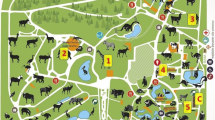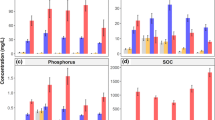Abstract
Foot and mouth disease and avian influenza are highly contagious. The foot and mouth disease virus can be transmitted in a number of ways, including close-contact animal-to-animal spread, long-distance aerosol spread, and fomites (inanimate objects, typically fodder and motor vehicles). Many burial sites were constructed in a short time to prevent the rapid spread of the Foot and mouth disease and avian influenza. These carcass burial sites pose a risk of secondary pollution because the sites were constructed without any appropriate or systematic management due to lack of time, equipment, and available labors. In 2011, more than 4700 carcass burial sites were constructed. Approximately 7 million poultry and 3.5 million livestock, including cattle and swine, were buried in farmland. Secondary pollution from these burial sites is a cause of concern. In practice, a number of burial sites were excavated, and the carcasses were reburied or disposed of elsewhere. To minimize risks to the environment and human health, the environmental impacts of the construction methods should be analyzed. This study used life cycle assessment methodology to investigate environmental impacts of the traditional carcass burial construction method and the redisposal construction using aerobic thermophilic microbes. All input data of raw materials and energy usage were collected, and an inventory was established. The burial process contributed to freshwater aquatic ecotoxicity potential, ozone depletion potential, and terrestrial ecotoxicity potential more than the redisposal process. However, the redisposal contributed to abiotic depletion potential, acidification potential, eutrophication potential, global warming potential, human toxicity potential, and photochemical oxidant creation potential more than the burial process.




Similar content being viewed by others
References
Ritter WF, Chirnside AEM (1996) Impact of dead bird disposal pits on groundwater quality on the Delmarva Peninsula. Bioresour Technol 53:105–111
Scudamore JM, Trevelyan GM, Tas MV, Varley EM, Hickman GAW (2002) Carcass disposal: lessons from Great Britain following the foot and mouth disease outbreaks of 2001. Rev Sci Technol 21:775–787
Gwyther LC, Williams PA, Golyshin NP, Jones GE, Jones LD (2011) The environmental and biosecurity characteristics of livestock carcass disposal methods: a review. Waste Manage 31:767–778
WAC (Washington Administrative Code) (2007) Disposal of dead livestock, No. 16–25. Washington State Legislature, Washington
Stettler D (2001) Mortality Management. Iowa State University, Ames
Kang MA (2011) Characteristic comparison of refractory organic matters in Andong Lake and FMD leachate. In: Proceedings of the 2011 fall co-conference of the korean society on water environment and korean society of water and wastewater, Kor Soc Water Environ and Kor Soc Water and Wastewater 455–456 (in Korean)
Park JA, Lee CG, Lee I, Min JE, Choi NC, Kim SB (2012) Transport of virus through carcass buried soils. In: Proceedings of the 2012 spring co-conference of the korean society on water environment and korean society of water and wastewater, Kor Soc Water Environ Kor Soc Water and Wastewater 684–685 (in Korean)
Cho HS, Kim GH (2012) Needs of biosecurity and protocols for the environmental management of carcasses burial. J Kor Soc Water Environ 28(2):305–312 (in Korean)
KRCC (2011) A study on the prevention of groundwater contamination by the leachate released from livestock mortality burials. Korea Rural Community Corporation, Ansan, pp 41–150 (in Korean)
Kim G, Seol SS (2015) Valuation of the stabilization plan for the foot-and-mouth disease burial sites. Environ Eng Res 20(1):59–63
ISO (2006) Environmental management—life cycle assessment—principles and framework, ISO 14040:2006(E). International Organization for Standardization, Geneva
ISO (2006) Environmental management—life cycle assessment—requirements and guidelines, ISO 14044:2006(E). International Organization for Standardization, Geneva
Prysor WA, Gareth E, Jones DL (2009) In-vessel bioreduction provides an effective storage and pre-treatment method for livestock carcasses prior to final disposal. Bioresour Technol 100:4032–4040
Edwards DR, Daniel TC (1992) Environmental impacts of on-farm poultry waste disposal—a review. Bioresourc Technol 42:9–33
Pratt DL (2009) Environmental Impact of Livestock Mortalities Burial. Master’s Thesis, University of Saskatchewan, Canada, pp 46–82
Keizer EE, Kok HJG (2011) Environmental impact of different funeral technologies. TNO Innovation, Appendix C
Watkiss P, Smith A (2001) CBA of foot and mouth disease control strategies: environmental impact, ED51178001. AEA Technology Environment, London
UKEA (2004) Assessing the groundwater pollution potential of cemetery developments, Environment Agency, Bristol
Nursch A, Spire M (2004) Chapter 1 burial in carcass disposal: a comprehensive review. National Agricultural Biosecurity Center Consortium, Kansas
KECO (2009) A study on the environmental assessment of surrounding area of AI outbreak. Korean Environment Corporation, Incheon
NIER (2011) Biodegradation of livestock carcass and evaluation of secondary pollution to surrounding environment(II). National Institute of Environmental Research, Incheon
MOE (2010) Environment management guideline of carcass burial sites. Ministry of Environment, Seoul
MAFRA (2011) Standard operating procedures for FMD, Ministry of Agriculture, Food and Rural Affairs, Sejongsi
IEA, International Energy Annual (2000–2002). International Energy Agency, Paris
U.S. Geological Survey (2001–2002) Minerals statistics and information, mineral commodity summaries. United States Geological Survey, Reston
Hauschild M, Wenzel H (1998) Environmental assessment of product: volume 2: scientific background. Chapman & Hall, London
Heijungs R, Guinée JB, Huppes G, Lankreijer RM, Udo de Haes HA, Wegener Sleeswijk A, Ansems AMM, Eggels PG, Duin R van, Goede HP de (1992) Environmental life cycle assessment of products: guide and backgrounds. Centre of Environmental Science (CML), Leiden
Huijbregts M (1999) Priority assessment of toxic substances in LCA: development and application of the multi-media fate, exposure and effect model USES-LCA. IVAM environmental research, Amsterdam
Huijbregts M (2000) Priority assessment of toxic substances in LCA: time horizon dependency of toxicity potentials calculated with the multi-media fate, exposure and effects model USES-LCA. Institute for Biodiversity and Ecosystem Dynamics, Amsterdam
IPCC (1996) Guidelines for national greenhouse gas inventories. International Panel of Climate Change, Geneva
UNEP (2002) Annual Report, United nations environment programme, Nairobi
Jenkin ME, Hayman GD (1999) Photochemical ozone creation potentials for oxygenated volatile organic compounds: sensitivity to variations in kinetic and mechanistic parameters. Atmos Environ 33(8):1275–1293
Derwent RG, Jenkin ME, Saunders SM, Pilling MJ (1998) Photochemical ozone creation potentials for organic compounds in northwest Europe calculated with a master chemical mechanism. Atmos Environ 32(14):2429–2441
Wu JG, Meng XY, Liu XM, Liu XW, Zheng ZX, Xu DQ, Sheng GP, Yu HQ (2010) Life cycle assessment of a wastewater treatment plant focused on material and energy flows. Environ Manage 46(4):610–617
Aja OC, Al-Kayiem HH (2014) Review of municipal solid waste management options in Malaysia, with an emphasis on sustainable waste-to-energy options. J Mater Cycles Waste 16(4):693–710
Borghi AD (2013) LCA and communication: environmental product declaration. Int J Life Cycle Ass 18(2):293–295
Acknowledgments
This study was supported by the Korean Ministry of Environment under the GAIA Project.
Author information
Authors and Affiliations
Corresponding author
Rights and permissions
About this article
Cite this article
Kim, M.H., Kim, G. Analysis of environmental impacts of burial sites. J Mater Cycles Waste Manag 19, 432–442 (2017). https://doi.org/10.1007/s10163-015-0439-y
Received:
Accepted:
Published:
Issue Date:
DOI: https://doi.org/10.1007/s10163-015-0439-y




